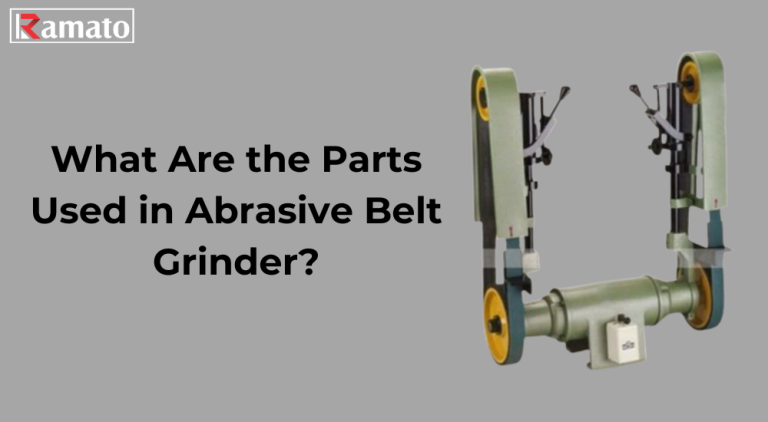What Are the Parts Used in Abrasive Belt Grinder? A Detailed Overview

An abrasive belt grinder is an important tool in many material processing industries like metal and wood. For its proper utilization and management, it is imperative to understand the system’s makeup.
What are the Parts Used in Abrasive Belt Grinder
Now let us examine ‘The Parts Used in Abrasive Belt Grinder‘:
Main Frame Structure
The main frame structure is made from mild steel. This robust framework supports all other components, ensuring stability during operation. One important aspect during the assembly process is the alignment of the bearings so that misalignment and, hence, improper functioning are avoided.
The frame also has provisions for grease that can be used to coat the bearings and enhance their durability. In an abrasive belt grinder, the main frame structure is the backbone, securely holding everything together.
Roller Shaft: Integral to Abrasive Belt Grinder Functionality
The roller shaft is meticulously machined according to specifications. One end of the shaft holds the ‘V’ belt pulley, while the other end is fixed to the frame structure. The central portion is machined to fit the bearing and act as a roller wheel.
Connected inside the main body and through the ‘V’ belt pulley, this roller shaft, in turn, drives the abrasive belt efficiently. The roller shaft is one of the important parts of any abrasive belt grinder since it enables the belt to move uniformly.
‘V’ Pulley: Power Transmission in Abrasive Belt Grinder
Made from cast iron and machined to a standard type with a single ‘A’ groove, the ‘V’ pulley is crucial for power transmission. The pulley, driven by the motor, rotates the roller through the ‘V’ belt.
Primarily used to rotate the spindle at about 2000 rpm, the ‘V’ pulley makes a significant contribution to the smooth performance of the product. An abrasive belt grinder is used to transform the power produced by the motor to the belt.
Bearing Cap with Bearing: Smooth Operation of Abrasive Belt Grinder
The bearing cap with bearing secures the roller wheel, ensuring it operates smoothly. Proper boring of bearing sizes and open bores in one setting is essential for alignment during assembly. The cap also shields the bearing; thus, the abrasive belt grinder has a longer life cycle. Therefore, the integrity of the bearing cap and bearings ensures that the mechanism of the roller wheel Is sustained, which is vital to the functionality of the abrasive belt grinder.
Abrasive Belt
It is placed in between two cylindrical rollers. Usually, the belt is coated with aluminum oxide or silicon carbide to grind and sand the material. The rotation, which is made possible by a single-phase induction motor, enables the belt grinder to grind, shape, and then finish products. In itself, an abrasive belt grinder cannot function properly without the abrasive belt as it is designed for its use.
Roller Wheel
The roller wheel, mounted on two end bearings with a bearing cap, ensures the abrasive belt moves smoothly. The assembly allows the belt to rotate effectively, driven by the motor via the belt drive mechanism. This rotation is fundamental to the grinding process, enabling the belt to contact the material evenly. Typically, the roller wheel ensures proper belt tension and traveling mechanism.
Single-Phase Induction Motor: Power Source of Abrasive Belt Grinder
The single-phase induction motor powers the abrasive belt grinder. Connected to the ‘V’ pulley, the motor drives the abrasive belt through the belt drive mechanism. Consistent spinning and power supply is what this engine ensures, which is important in grinding and sanding for the best results. In an abrasive belt grinder, the single-phase induction motor provides enough torque required to keep the belt moving thus helping to maintain its operation.
Other Components of Abrasive Belt Grinder
- Height Adjustable Work Table: To accommodate different workpieces, this characteristic allows adjustments of heights and angles.
- Tracking Mechanism: It ensures that the abrasive belt remains centered on the rollers during operation.
- Safety Features: This includes guards, shields, and emergency stop switches to shield users from danger.
Functions of Grinding and Sanding Using an Abrasive Belt Grinder
If you keep wondering about ‘What are the Parts Used in Abrasive Belt Grinder?’ then you must also know that they are not limited to one purpose:
- Grinding – shaping metal parts; sharpening metal parts.
- Sanding – smoothing wood surfaces; shaping edges of wood.
- Deburring – removing burrs or imperfections from metal surfaces.
- Finishing – getting surfaces ready for further treatments such as welding or painting them afresh.
Varieties of Abrasive Belt Grinders
Different types of abrasive belt grinders are meant for different purposes:
- Stationary Belt Grinders – large machines sitting on a bench or stand made specifically for heavy-duty grinding jobs.
- Portable Belt Sanders- used for light duties by small workshops.
Variability and Customization in Abrasive Belt Grinders
Speed settings of abrasive belt grinders are adjustable, enabling the operator to adjust grinding speed according to material and desired finish; this is common In almost all abrasive belt grinders. Exchangeable grit size belts are used to obtain different roughnesses and finishes.
What Are Abrasive Belt Grinders Used For?
These are used across numerous industries:
- Metalworking: In metal fabrication shops, these machines are typically used for grinding off bits of metal, deburring or finishing welds, and rounding edges on surfaces.
- Woodworking: They are normally used for sanding wood surfaces, shaping edges, and removing material quickly.
- Automotive: Grinding and sanding metal surfaces takes place during automotive repair and restoration.
Conclusion
Understanding ‘What are the Parts Used in Abrasive Belt Grinder’ is essential for effective operation and maintenance. Thus, you can ensure your abrasive belt grinder operates smoothly, delivering optimal performance in various applications. Embrace these insights to maximize the efficiency and lifespan of your abrasive belt grinder.
